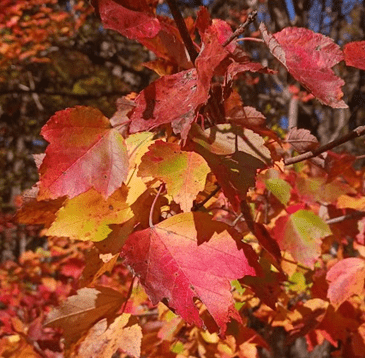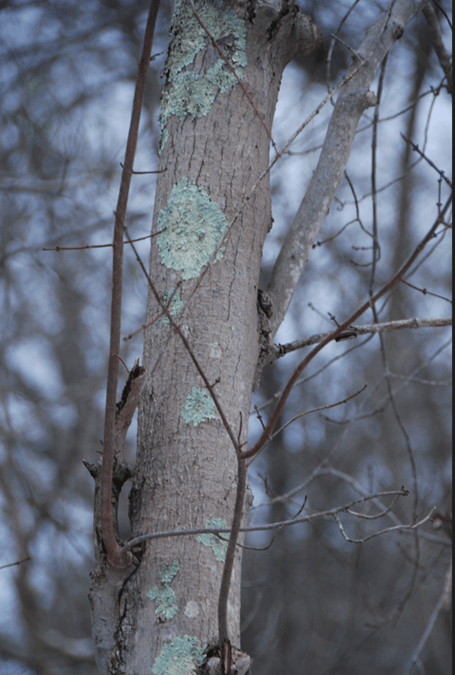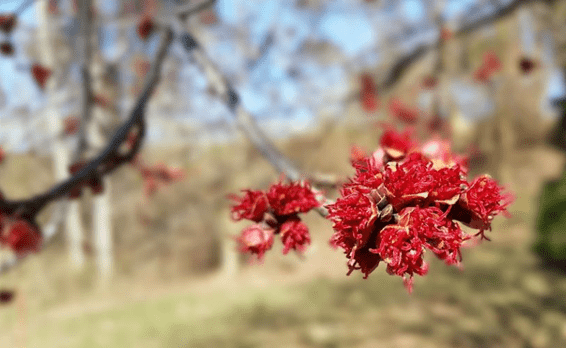John Hooven, Cape Atlantic (NJ) Conservation District forester

Red maple (Acer rubrum) leaves
Red Maple, Acer rubrum, is one of the most commonly occurring trees in eastern North America. The tree is well adapted to many different site conditions, from lowlands to uplands, and shady to sunny. The tree also thrives on a variety of different soil types with various pH levels. The species has a wide geographic range, from Florida and the mid-west all the way up across southern Canada. The prolific red maple also ranges from sea level to elevations as high as 3,000’. Therefore, its suitable habitat can be found across the entirety of Maryland.

Red maple is a soft maple, unlike the hard maples of sugar maple and black maple. Still, in comparison to other hardwoods, red maple falls just below black walnut but the same hardness as black cherry, and harder still than silver maple and pine. While its utilization is limited, better specimens can sometimes be substituted for hard maple in furniture. The biggest issue with utilizing maple is its form of growth. It is not always common to find timber quality red maples in the forest. Maple has a tendency to branch low, at times even rising from the ground as multiple stems, and will follow the light as it is growing. With silviculture, red maple could be grown to favor timber producing specimens. Doing so would be a quick turnaround for a hardwood since the tree reaches maturity in 70 to 80 years, but rarely living beyond 150. Red maples can also be used in the production of maple syrup, though more sap is needed to be boiled as the amount of sugars is lower than that of Acer saccharum, sugar maple.
Where red maple truly excels is as a landscape tree. The tree grows fast and can produce a nice shade tree in a relatively short time frame. The tree’s best asset, though, is its fall color, making it one of the best trees to have in the landscape in autumn. It can be useful for planting adjacent to parking lots. However, site conditions will determine if the roots will grow vertically without issues or run laterally, creating bumps in the pavement over time.
Wetter sites are more likely to see roots running laterally, and dry sites the opposite. Red maple can be found just about anywhere as its genetics allow it to be quite adaptable.
The tree flowers early in spring with bright red, tiny, perfect flowers. Sexual maturity can exhibit in as little as four years aiding to the tree’s numbers across its range. The species has an interesting sexuality known as polygamo-dioecious: some trees are male, some are female, and some are monoecious having both male and female flowers. The tree is one of the first to bloom and seed in the spring. Small winged samaras, typically red, are dispersed in spring. The tree is good for providing food and habitat for wildlife.

The tree is part of the phenomena known as mesophication. Since colonial times, use of fire as a management tool has decreased across the range of red maple. Red maple is fire intolerant, and in the absence of fire, cool, damp and shaded conditions favor mesophytes such as maples. This is leading to an increase in red maple across its range while also leading to a decrease in oaks and other sunlight favored species. This can be problematic as some of these sunlight favoring genera, like oaks, or Quercus, support more pollinating species than Acer. Regardless, there is no doubt of the vigor of the red maple, and even with active management to favor sunlight favoring species, there will be no shortage of Acer rubrum in the landscape.
Source:
Burns, R. and Honkala, B. Silvics of North America Volume 2. Hardwoods. United States Department of Agriculture (USDA), Forest Service, Agriculture Handbook 654.
Branching Out, Vol. 32, no. 3 (Summer 2024)
Branching Out is the free, quarterly newsletter of the Woodland Stewardship Education program. For more than 30 years, Branching Out has kept Maryland woodland owners and managers informed about ways to develop and enhance their natural areas, how to identify and control invasive plants and insects, and about news and regional online and in-person events.